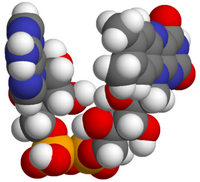
Photo from wikipedia
Enzymes catalysing sequential reactions have developed different mechanisms to control the transport and flux of reactants and intermediates along metabolic pathways, which usually involve direct transfer of metabolites from an… Click to show full abstract
Enzymes catalysing sequential reactions have developed different mechanisms to control the transport and flux of reactants and intermediates along metabolic pathways, which usually involve direct transfer of metabolites from an enzyme to the next one in a cascade reaction. Despite the fact that metabolite or substrate channelling has been widely studied for reactant molecules, such information is seldom available for cofactors in general, and for flavins in particular. Flavin adenine dinucleotide (FAD) and flavin mononucleotide (FMN) act as cofactors in flavoproteins and flavoenzymes involved in a wide range of physiologically relevant processes in all type of organisms. Homo sapiens riboflavin kinase (RFK) catalyses the biosynthesis of the flavin mononucleotide cofactor, and might directly interplay with its flavin client apo-proteins prior to the cofactor transfer. Non-etheless, none of such complexes has been characterized at molecular or atomic level so far. Here, we particularly evaluate the interaction of riboflavin kinase with one of its potential FMN clients, pyridoxine-5′-phosphate oxidase (PNPOx). The interaction capacity of both proteins is assessed by using isothermal titration calorimetry, a methodology that allows to determine dissociation constants for interaction in the micromolar range (in agreement with the expected transient nature of the interaction). Moreover, we show that; i) both proteins become thermally stabilized upon mutual interaction, ii) the tightly bound FMN product can be transferred from RFK to the apo-form of PNPOx producing an efficient enzyme, and iii) the presence of the apo-form of PNPOx slightly enhances RFK catalytic efficiency. Finally, we also show a computational study to predict likely RFK-PNPOx binding modes that can envisage coupling between the FMN binding cavities of both proteins for the potential transfer of FMN.
Journal Title: Frontiers in Molecular Biosciences
Year Published: 2023
Link to full text (if available)
Share on Social Media: Sign Up to like & get
recommendations!